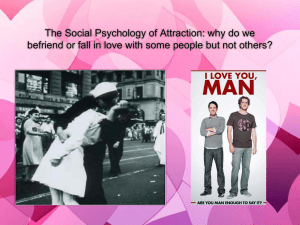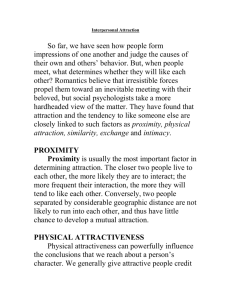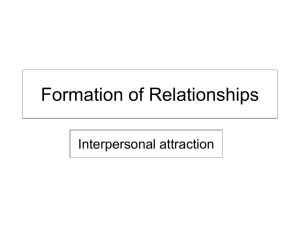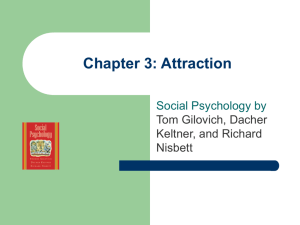Chapter 9 Suggested Answers Review 9.1 1 Interpersonal attraction
advertisement
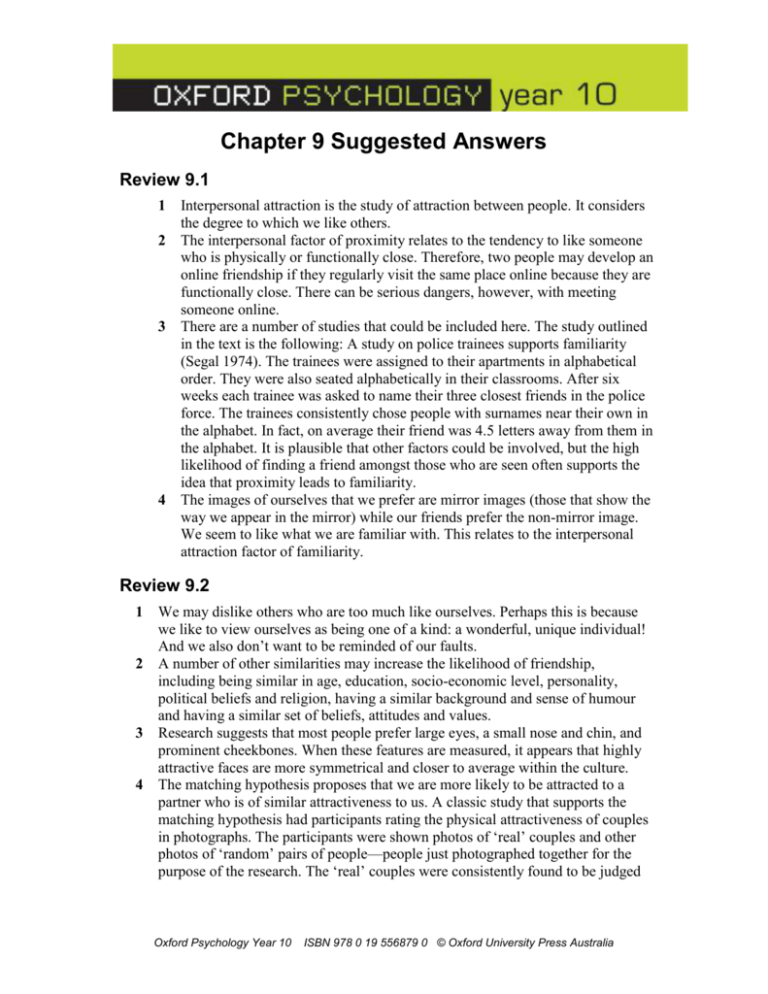
Chapter 9 Suggested Answers Review 9.1 1 2 3 4 Interpersonal attraction is the study of attraction between people. It considers the degree to which we like others. The interpersonal factor of proximity relates to the tendency to like someone who is physically or functionally close. Therefore, two people may develop an online friendship if they regularly visit the same place online because they are functionally close. There can be serious dangers, however, with meeting someone online. There are a number of studies that could be included here. The study outlined in the text is the following: A study on police trainees supports familiarity (Segal 1974). The trainees were assigned to their apartments in alphabetical order. They were also seated alphabetically in their classrooms. After six weeks each trainee was asked to name their three closest friends in the police force. The trainees consistently chose people with surnames near their own in the alphabet. In fact, on average their friend was 4.5 letters away from them in the alphabet. It is plausible that other factors could be involved, but the high likelihood of finding a friend amongst those who are seen often supports the idea that proximity leads to familiarity. The images of ourselves that we prefer are mirror images (those that show the way we appear in the mirror) while our friends prefer the non-mirror image. We seem to like what we are familiar with. This relates to the interpersonal attraction factor of familiarity. Review 9.2 1 2 3 4 We may dislike others who are too much like ourselves. Perhaps this is because we like to view ourselves as being one of a kind: a wonderful, unique individual! And we also don’t want to be reminded of our faults. A number of other similarities may increase the likelihood of friendship, including being similar in age, education, socio-economic level, personality, political beliefs and religion, having a similar background and sense of humour and having a similar set of beliefs, attitudes and values. Research suggests that most people prefer large eyes, a small nose and chin, and prominent cheekbones. When these features are measured, it appears that highly attractive faces are more symmetrical and closer to average within the culture. The matching hypothesis proposes that we are more likely to be attracted to a partner who is of similar attractiveness to us. A classic study that supports the matching hypothesis had participants rating the physical attractiveness of couples in photographs. The participants were shown photos of ‘real’ couples and other photos of ‘random’ pairs of people—people just photographed together for the purpose of the research. The ‘real’ couples were consistently found to be judged Oxford Psychology Year 10 ISBN 978 0 19 556879 0 © Oxford University Press Australia 5 6 7 as more equal in attractiveness than the ‘random’ pairs. We seem to select people who are equal in attractiveness. The complementary factor is where one person seeks one thing from a relationship while the other seeks something else. People like to be with others whose needs, behaviours and resources complement their own. This provides a balance and some evidence that similarity in terms of attractiveness may not always be important. A less attractive person may seek attractive friends to complement their own great sense of humour. Scars do not seem to be unattractive, either to males or females. Heterosexual females may even view scars as attractive because they indicate health and bravery, at least in the short term! This is a fairly new area of research and more is needed before definitive conclusions can be reached. Speed-dating may help in short-term relationships— people sum up each other very quickly (within three seconds) and, if positive, this may lead to a first or second date. Long-term relationships most likely depend on a number of other factors. Review 9.3 1 2 3 4 5 6 People are more inclined to like those who display positive attitudes towards others and life in general than those who display negative attitudes. Psychologically attractive people are friendly, and patient and have a ‘warm’ personality. Any example where two people think the same of each other; for example, if person A likes person B, that will cause person B to like person A. If person B detects that a compliment from person A is not genuine, then person B is likely to think less of person A as the fake compliment probably shows that person A think less of person B. Gain–loss theory states that we will like someone more if that person originally didn’t like us, but now does. Conversely, if the person originally liked us but then changed their mind, we will dislike that person more than someone who didn’t like us from the beginning. There are a number of factors, including: the role of pheromones (bodily odours). We all secrete a unique, genetically determined body odour that influences attraction. parts of the brain, including the limbic system. The limbic system drives our emotions and therefore influences our feelings towards others. hormones such as oxytocin. There is evidence that oxytocin plays a major role in attraction, particularly in loving relationships. There are a number of criticisms of past research, including: It mainly concentrated on heterosexual relationships. It looked at just two people and usually only very short-term relationships, such as one or two dates. Oxford Psychology Year 10 ISBN 978 0 19 556879 0 © Oxford University Press Australia Some studies lacked reality—it was not carried out in a real setting in everyday life. Many participants were in their late teens and early twenties; a time when people tend to overemphasise the importance of physical attractiveness. Research methodology is changing and today there is more research considering: practical implications in the natural world, with research in naturalistic settings rather than in artificial circumstances impacts of modern technology, such as Internet social networking pages, chat rooms and video links cultural aspects and differences relationships between friends (platonic relationships)—both same sex and opposite sex same-sex romantic relationships longer-term studies—more than just a glimpse (snapshot) at one time, mainly with college students other factors, such as third-party influences; for example, the role of family members and other friends. Test Your Understanding 1 2 3 4 5 6 7 8 9 A C A C B It is easier to meet someone if they are physically or functionally close to us. Being in close proximity allows us to meet the person in the first place. Proximity leads to more exposure, which leads to familiarity. Being in the same place may also be due to similarity, such as, possessing similar backgrounds or interests. The matching hypothesis proposes that we are more likely to be attracted to a partner who is of similar attractiveness to us. Being in the same place (proximity) may also be due to similarity; for example, possessing similar backgrounds or interests has drawn you to the same place. a Yes. Both people are online (functionally close) and then could find out whether they have similar attitudes, backgrounds and interests to one another. Both people could be similar in terms of wanting to find a romantic partner. Alternatively, one or both people may be pretending to be similar in order to increase the role of similarity. This highlights a serious danger with meeting people online. b There are other reasons, including: • familiarity—recognising the person’s name and becoming familiar with their life, style of writing, etc .; even if the details they give are not true. • reciprocity—thinking that they like you is likely to mean that you like them. Oxford Psychology Year 10 ISBN 978 0 19 556879 0 © Oxford University Press Australia c Safe and valuable long-distance Internet friendships are known to occur. It can help someone overcome loneliness or assist them when, for some reason, they are unable to meet others/leave the house. However, chat rooms can be very dangerous. Some users prey on others, and know what to write in order to increase interpersonal attractiveness. A person using chat rooms should always be on guard and never divulge too much personal information. Check out the government guidelines at the website of the Department of Education and Early Childhood Development (www.education.vic.gov.au/healthwellbeing/safety/bullying/default.htm). 10 The answer requires you to think about how you become friends: where, when and why did you become friends? 11 a Strong friendships are important. We are very social creatures and studying this topic can help us understand why we like some people and not others. It can help those who want to develop new friendships and can apply to a range of other settings, such as getting along with people at work and within family settings. Having strong friendships can build self-esteem and confidence, help us cope with difficult periods in our lives and lead to a more fulfilling life. b While these factors are generally found in most situations, they are not absolute. Each person is complex. What attracts us to friends may not always be according to the findings mentioned in this chapter. Each of us comes with our own unique biology and experiences and each person’s likes and dislikes will differ from those of others. 12 Students’ own answers. Oxford Psychology Year 10 ISBN 978 0 19 556879 0 © Oxford University Press Australia
